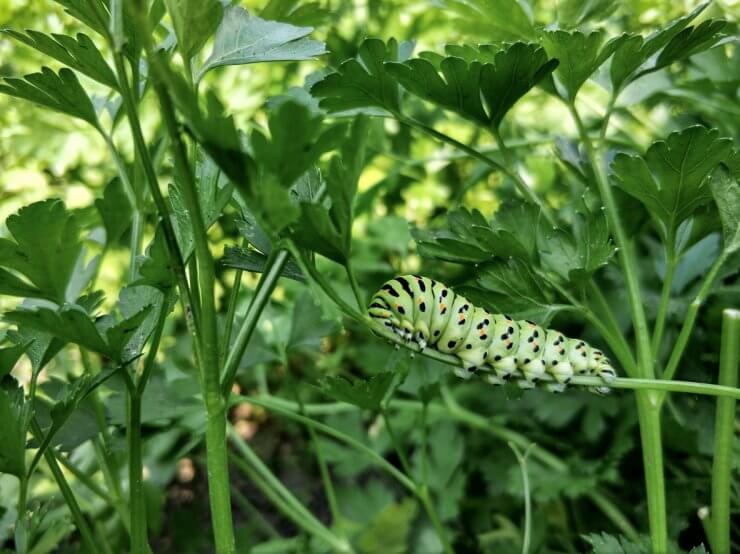
Swallowtail caterpillar on parsley
Have you noticed something wrong on the leaves of your parsley plants? Do you see holes forming on the leaves that may indicate something is eating away at your tasty parsley? Or is your parsley plant discolored or just not looking very healthy? One of the biggest challenges of gardening is keeping the pests away. The following pests are known for attacking parsley plants—and here’s how to treat each problem:
Aphids
How to Spot Aphids: Aphids are small green or yellow insects that can nest on the undersides of leaves and on the stems of garden plants. Extensive aphid infestation can cause plant leaves to turn yellow or to become distorted—and with parsley, yellow coloring is very unappetizing! Aphids also promote the growth of mold on plants when they secrete a sticky, sugary honeydew substance.
How to Manage Aphids: If you can find aphid-tolerant parsley varieties, it’s worth it to give them a try. With any seedlings, always check for aphids or other insects, especially on the undersides of leaves, before planting and possibly infesting your whole garden. If your parsley plants get afflicted with aphids and the infestation is limited to just a few leaves, prune the infected parts of the plants (they’ll grow back) and destroy the cuttings. If the infestation is more widely spread, try spraying any sturdy plants and stems with a strong jet of water to knock the aphids off the plants. For near-total infestation, try an organic homemade insecticide of garlic water to get rid of the aphids—here is how to make a garlic-water insecticide:
- Process one small head of unpeeled garlic in a food processor until smooth.
- Add two cups of warm tap water to the food processor and pulse a couple of times.
- Pour the mixture into a container, cover tightly, and place in your pantry overnight.
- When ready to use, strain the mixture of all the solids and dilute the remainder with one gallon of water.
- Place diluted solution in a spray bottle and treat the plants, on the tops and bottoms of the leaves, once a week until the insects are gone.
- Store your homemade insecticide in the refrigerator when not in use.
For prevention of aphids in the first place, try reflective mulches—such as silver-colored plastic (the bright reflection of light to the underside of leaves can repel insects)—to stop aphids from feeding on your plants. Note: Wasps love parsley plants and prey on aphids—so, don’t try to repel or remove wasps from your garden; they can be nature’s aphid-removers!
Armyworm
How to Spot Armyworms: Armyworms are greenish-brownish caterpillars that grow up to 2 inches in length—and their egg clusters can be identified by a whitish fuzzy covering on the leaves or stems of your plants. Evidence of armyworm infestation includes holes in leaves from the pests devouring the greenery for dinner. And the young larvae feast on the foliage, too, making the leaves look skeletonized. If you see missing leaves or leaves with these types of holes on your parsley plants, you might suspect armyworms—but, because armyworms are nocturnal, they hide out at the base of parsley plants in the soil during the day and only come out to eat at night. If you venture into your garden at night with a flashlight, you can confirm if armyworms are the culprits eating your parsley.
How to Manage Armyworms: Some of the best methods for controlling armyworms are already found in nature—natural predators such as ladybugs, wasps, and spiders. You can remove armyworms yourself by hand at dawn or dusk when they are still out munching on your parsley. Toss removed armyworms into a bucket of hot water to kill them, and destroy the dead pests when done.
Cutworms
How to Spot Cutworms: Like armyworms, cutworms are greenish-brownish caterpillars that also grow up to 2 inches in length—but they don’t climb the plants to feast. Cutworms subsist by chowing down on the stems and shoots of young seedlings and on the toppled parts of plants on the ground. And like armyworms, cutworms are nocturnal and hide in the soil at the base of parsley plants.
How to Manage Cutworms: Remove cutworms from the base of plants by hand at dusk or dawn when they come out to eat—and toss them into a bucket of hot water to kill them before destroying and disposing of the cutworms. But, it can be hard to see and find cutworms when they are hiding in the soil—so, prevention can be the best method of all! To prevent cutworms from invading your parsley plants, fit plastic or foil collars around plant stems to cover the bottom 3 inches above the soil line and extending a couple of inches below into the soil. Or build a 1-inch deep “moat” around each plant stem and fill with plastic or folded newspaper as a barrier to preventing cutworms from ever reaching your parsley plants.
Parsley Worm
How to Spot Parsley Worm: The parsley worm is another type of caterpillar that particularly loves finding refuge in parsley plants. Parsley worms grow to 2 inches in length and are distinctive and identifiable by their black stripes and yellow dots. Parsley worms feast on the leaves of parsley plants.
How to Manage Parsley Worm: As caterpillars, parsley worms are pesky pests, devouring your herbs—but they can be ultimately beneficial to your garden when transformed into adult butterflies, because they can help pollinate all of your garden flowers. If you encounter parsley worms on your plants, try segregating them onto a few plants in your garden and let them thrive there until they become butterflies—sacrificing a few parsley plants for the good of your entire garden makes good sense!
Do pests attack your parsley plants every year? How do you handle removing them—and even preventing them in the first place? Please tell us how you treat your parsley plants to avoid pests.


 Previous
Previous

